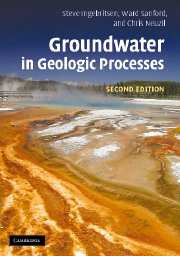Book contents
- Frontmatter
- Contents
- Preface
- Acknowledgements
- List of symbols
- 1 Groundwater flow
- 2 Hydromechanical coupling
- 3 Solute transport
- 4 Heat transport
- 5 Regional-scale flow and transport
- 6 Ore deposits
- 7 Hydrocarbons
- 8 Geothermal processes
- 9 Earthquakes
- 10 Evaporites
- 11 Compaction and diagenesis
- 12 Metamorphism
- 13 Subsea hydrogeology
- References
- Index
Preface
Published online by Cambridge University Press: 12 January 2023
- Frontmatter
- Contents
- Preface
- Acknowledgements
- List of symbols
- 1 Groundwater flow
- 2 Hydromechanical coupling
- 3 Solute transport
- 4 Heat transport
- 5 Regional-scale flow and transport
- 6 Ore deposits
- 7 Hydrocarbons
- 8 Geothermal processes
- 9 Earthquakes
- 10 Evaporites
- 11 Compaction and diagenesis
- 12 Metamorphism
- 13 Subsea hydrogeology
- References
- Index
Summary
Historically, interest in groundwater and other subsurface fluidswas confined to a few specific disciplines in the Earth sciences, notably groundwater hydrology, soil physics, engineering geology, petroleum geology, and petroleum engineering. These disciplines tended to be “applied” in nature, with practitioners concentrating on the immediate and practical problems of water supply, water quality, mine dewatering, deformation under structural loads, and the location and recovery of fluid hydrocarbons.
This situation has changed over the past few decades. Hydrogeologists and geologists are now actively exploring the role of groundwater and other subsurface fluids in such fundamental geologic processes as crustal heat transfer, ore deposition, hydrocarbon migration, earthquakes, tectonic deformation, diagenesis, and metamorphism. Groundwater in Geologic Processes is the first comprehensive treatment of this body of inquiry. Relative to the first edition of Groundwater in Geologic Processes, this second edition includes a much more comprehensive treatment of hydromechanics (the coupling of groundwater flow and deformation). It includes new chapters on “compaction and diagenesis,” “metamorphism,” and “subsea hydrogeology.” It also takes advantage of the substantial body of published research that has appeared since the first edition in 1998.
The growth of interest in the role of groundwater in geologic processes is indicated by the popularity of regularly scheduled meetings on “Water–Rock Interaction” and “Geofluids”, by Penrose Conferences such as “Continental Magmatic-Hydrothermal Systems” (2004), and by an increasing number of related symposia at annual meetings of the American Geophysical Union and the Geological Society of America. Other indices of interest include the success and longevity of an annual, informal “Hubbert Quorum” on groundwater and geologic processes and the birth of a new journal dedicated to Geofluids.
We have attempted an integrated and systematic accounting of this body of inquiry, suitable for use as an adjunct to more-or-less general curricula in hydrogeology and geology, or as the primary text for courses on groundwater and geologic processes. The books that come closest to addressing the intended audience (Fluids in the Earth's Crust by Fyfe and others, 1978; Geology and Water by Chapman, 1981; Physical and Chemical Hydrogeology by Domenico and Schwartz, 1990; Introduction to Hydrogeology by Deming, 2002; and Geodynamics by Turcotte and Schubert, 2002) in fact touch on only a few of the couplings between geology and groundwater, or are specific to particular hydrogeologic environments (e.g., Hydrogeology of the Ocean Lithosphere by Davis and Elderfield, 2004).
- Type
- Chapter
- Information
- Groundwater in Geologic Processes , pp. xiii - xviiPublisher: Cambridge University PressPrint publication year: 2006

